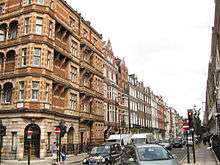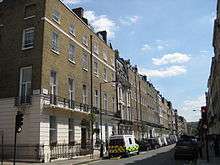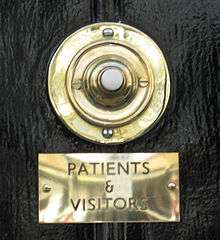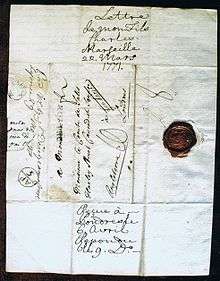Harley Street
Harley Street is a street in Marylebone, central London, which has been noted since the 19th century for its large number of private specialists in medicine and surgery.[1] It was named after Thomas Harley who was Lord Mayor of London in 1767.[2]




Overview
Since the 19th century, the number of doctors, hospitals, and medical organizations in and around Harley Street has greatly increased. Records show that there were around 20 doctors in 1860, 80 by 1900, and almost 200 by 1914. When the National Health Service was established in 1948, there were around 1,500. Today, there are more than 3,000 people employed in the Harley Street area, in clinics, medical and paramedical practices, and hospitals such as 111 Harley St., The Harley Street Clinic, Hifu Skin Clinic, Medical Express Clinic, Harly Medical Foot and Nail Clinic, Harley Street Fertility Clinic, Sonoworld Diagnostic Services, The London Women's Clinic and The London Clinic.[3][4][5]
It has been speculated that doctors were originally attracted to the area by the development of commodious housing and central proximity to the important railway stations of Paddington, King's Cross, St Pancras, Euston and, later, Marylebone. The nearest Tube stations are Regent's Park, Great Portland Street and Oxford Circus. Harley Street has also been featured in many films and television programmes.
Land ownership
Harley Street is part of the Howard de Walden Estate.
Notable occupants
Many famous people have lived or practised in Harley Street, including the Victorian Prime Minister William Ewart Gladstone, the artist J. M. W. Turner and the speech therapist Lionel Logue. Queen's College, founded in 1848 and one of the oldest girls' schools in England, is situated on Harley Street.
- Sir Charles Lyell (lawyer, author and geologist). Lived at No.11 (which is now No.73).[6]
- Sir William Beechey (Portrait painter) lived at No.13.[7]
- Sir Grantly Dick-Read (Obstetrician) lived and had his practice at No.23. Green Plaque.[8]
- Charles Wilson, 1st Baron Moran, Winston Churchill's personal physician, had a private practice at No. 29 during the 1920s and 1930s.[9]
- Sir Harold Ridley (Pioneering Ophthalmologist). Lived at No.53.[10]
- Sir James Galloway (1862-1922), dermatologist, practised at No. 54
- Sir Stewart Duke-Elder (Ophthalmologist) lived & worked at No.63. Blue Plaque.[10]
- J. M. W. Turner (Landscape painter) lived at No.64 from 1799 to 1805.[11]
- Allan Ramsay (Portrait painter) lived at No.67.[12]
- Violet Edith Grey-Egerton, daughter of Sir Philip le Belward Grey-Egerton, 11th Bt. and Hon. Henrietta Elizabeth Sophia Denison, and wife of John Gaspard le Marchant Romilly, 3rd Baron Romilly, died on 1 March 1906 at age 36 at 77 Harley Street.[13]
- Stafford Northcote, 1st Earl of Iddesleigh (British Politician, Conservative Chancellor of the Exchequer) lived at No.86.[7]
- Harriet Harman MP QC, Labour politician, born at 108 Harley Street.
- George Frederick Bodley (Greek Revival Architect) lived at No.109 from 1862 to 1873. Blue Plaque.
- Lionel Logue (Speech therapist), from Australia, had his practice at No.146. He helped King George VI overcome his stammer with lessons here. There is a Green Plaque.[14]
- William Henry Giles Kingston, Victorian author of boys' adventure novels, was born on Harley Street, 28 February 1814.[15]
- Sir Arthur Wellesley, the future Duke of Wellington, had his first London residence in Harley Street.
- John St. John Long, a famous quack, practiced in Harley Street from 1827–1834.
- Sir Morell Mackenzie (1837-1892), the 'Father of British Laryngology' lived in 19, Harley Street till his death. Involved in the great controversy while treating the German Crown Prince Fredrick III, the Son-in-law of Her Majesty Queen Victoria for his Laryngeal Disease, allegedly Cancer of the left vocal cord which led to the demise of the Emperor in 1888.[16]
Fictional references
In Virginia Woolf's Mrs. Dalloway (1925), medical professional Sir William Bradshaw lives on Harley Street.
In Jane Austen's Sense and Sensibility (1813), the Dashwood sisters, Lucy Steele, Mrs Jennings, Edward Ferrars, and others spend some of their free time there while in London.
P.G. Wodehouse's Sir Roderick Glossop, the “nerve specialist", was said to maintain a practice on Harley Street.
In Agatha Christie’s The Secret of Chimneys (1925), Lord Caterham ruefully mentions that his doctor advised him to “avoid all worry. So easy for a man sitting in his consulting room in Harley Street to say that.” Earlier in the book, a surgeon in Harley Street is mentioned among names listed in a phone book.
In Agatha Christie's Death in the Clouds (1935), Dr. Bryan, one of the passengers and suspects of the murder, is a Harley Street physician.
In Agatha Christie’s And Then There Were None (1938), murder victim Dr Edward Armstrong is a Harley Street physician.
In Agatha Christie’s Crooked House (1949), Edith de Haviland visits Harley Street.
In the movie The Revenge of Frankenstein, Dr Victor Frankenstein aka Dr Franck after his brain transplant begins his medical practice on Harley Street W
In John Banville's The Untouchable,[17] Victor Maskell visits his doctor and is told "I should have thought you had died already, in a way." ... which is "not the kind of thing you expect to hear from a Harley Street consultant, is it."
See also
- List of eponymous roads in London
- Macquarie Street, Sydney
- Rodney Street, the Harley Street of the North, in Liverpool
- Welbeck Street
- Wimpole Street
- Weymouth Street Hospital
- Marion Yau aka Miss Foot Fixer, 46 Harley Street
References
- "Street stories - Harley Street". www.marylebonevillage.com. Retrieved 27 September 2017.
- "Ledbury & District U3A Local History Group". Malvern Gazette. 5 November 2016. Retrieved 6 November 2016.
- History of Harley Street at Harley Street Guide (commercial website)
- Alisha, Ali (14 July 2013). "Psychological Therapy in London". London: Harley Therapy Clinic. pp. 7–8. Archived from the original on 7 May 2019. Retrieved 19 September 2016.
Counselling Approaches
- "IVF Clinics | Fertility Clinics | The London Women's Clinic London". www.londonwomensclinic.com. Retrieved 3 January 2017.
- "Sir Charles Lyell Facts, information, pictures - Encyclopedia.com articles about Sir Charles Lyell".
- Henry Benjamin Wheatley; Peter Cunningham (24 February 2011). London Past and Present: Its History, Associations, and Traditions. Cambridge University Press. pp. 192–. ISBN 978-1-108-02807-3.
- Grantly Dick-Read
- Oxford Dictionary of National Biography, Volume 59. Oxford University Press. 2004. p. 503. ISBN 0-19-861409-8.
- David J. Apple (2006). Sir Harold Ridley and His Fight for Sight: He Changed the World So that We May Better See it. SLACK Incorporated. pp. 50–. ISBN 978-1-55642-786-2.
- "The Turner Society".
- Christopher Hibbert; John Keay; Julia Keay (23 March 2010). The London Encyclopaedia. Macmillan. ISBN 978-1-4050-4925-2.
- Mosley, Charles, editor. Burke's Peerage, Baronetage & Knightage, 107th edition, 3 volumes. Wilmington, Delaware, U.S.A.: Burke's Peerage (Genealogical Books) Ltd, 2003.
- "Historical plaques about Lionel Logue Open Plaques".
- Modern English Biography: Containing Many Thousand Concise Memoirs of Persons who Have Died Between the Years 1851-1900
- G. Androustos. Illness and Death of the Kaizer Fredrick III (!832-1888), The tremendous impact on politics. Journal of BUON 7: 389-395, 2002
- Banville, John (1997). The Untouchable (1st Vintage International ed.). Random House. p. 168. ISBN 0-679-76747-9.
External links
- The Harley Street Guide
- George Harley, doctor/3230 at Who Named It?